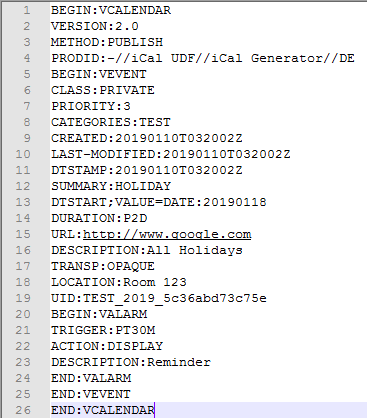Leaderboard
Popular Content
Showing content with the highest reputation on 02/14/2019 in all areas
-

OutlookTools
falcontechnics reacted to water for a file
Version 0.6.0.0
1,776 downloads
Built on top of the OutlookEX UDF it offers some often needed extended functionality (import/export ics/vcf/csv files etc.) (former name: iCal UDF). Note: This is a beta version - script breaking changes may occur at any time! Prerequisite: OutlookEX UDF. Details about all functions can be found in the Wiki. ICS (iCalendar) import - Import iCal events from an ICS file to an Outlook calendar VCF (vCard) import - Import vCard contacts to an Outlook contacts folder CSV import - Import data from a CSV file and create Outlook items in a specified folder Export - Export Outlook items (contacts, appointments) in VCF, ICS, CSV or Excel format Links: https://tools.ietf.org/html/rfc5545 (ICS - iCalendar) https://tools.ietf.org/html/rfc6350 (VCF - vCard) Threads: General Help & Support Known Bugs: (last changed: 2019-01-22) None Things to come: (last changed: 2022-01-25) Support for EML mails (email contents as plain text in MIME format) will be added BTW: If you like this UDF please click the "I like this" button. This tells me where to next put my development effort1 point -

WASAPI Audio Capture w/ loopback (WHAT U HEAR) UDF
argumentum reacted to Bilgus for a topic
Hey folks, I provided a broken example with the UDF. The wavsaver was writing junk for the wav header on the final save It is fixed NOW1 point -
1 point
-

Regex toolkit
Viszna reacted to BertKerkhof for a topic
I rewrote the program StringRegExpGui that is distributed with AutoIT3 and can be found in the \Examples\Helpfile folder. The RegExGui published today is a total remake and offers the following improvements: Examples Built-in and instant accessible with a menu. There are six instructional applications for finding names, phone numbers, dates, and the like. The direct and fast operation allows the user to take the lead in the little-practiced box of pattern recognition. Thanks FritsW. Daring All examples start with multiple finds that match the specified pattern. In addition, each match is immediately shown and dissected into parts. This is in contrast to software that starts with a single match or just the observation that a match has taken place. With the direct approach, the user jumps straight into the deep and can simplify the example as desired. This depth with RegExGui gives the best preparation for practical use. User-friendly On the screen is a ruler with numbers, so that an unexpected error in the manufacture of a pattern is now more quickly solved. Added are a number of tooltips. At will, the user can adjust and / or save the sample patterns. Growth The examples include links to sites that explain advanced regular expressions or provide tools. Furthermore, a link to a site for healthy food. Thanks JolandeS. The width of the dialog window of the program is adjustable. As patterns are better controlled, the user may want to go to long expressions. They can then remain completely in the picture. Thanks Melba23. Presentation Multiple results are presented in a two-dimensional way. Each match at the beginning of a line, optional decomposition of components in subsequent columns. As a result, a match will continue to be distinguished from a part that belongs to another match. The program now has a 256-bit icon with alpha transparency. Bright Textual explanations are given with the results. A lime background color is chosen for the status field. This improves the contrast. Thanks EmileR. Repair of errors A diagnosis has now been made regarding the exchange of detail - with primary match data in the results, when using the options Match and All matches. Until it is repaired, users can use the Match + detail and Ales Matches + details options. A bug in StringRegExpGui - the unexpected disappearance of all saved patterns - has been fixed. Thank LeaB. With RegExGUi, the patterns remain in the inifile in the same folder as the program. Happy Few users are aware of the invisibly different codings of the alphabet hidden under water in text files. Since the new millennium the use of unicode has been growing, it has many advantages. Here and there are 8 bit codings. They traversed searching in the past and especially finding it. Again without users knowing this, they have only experienced fruitlessness. The RegExGui presented here relieves the user for that matter in the whole. The program takes care of encoding and always comes up with the most complete results that fit your pattern, thanks DominiqueH. Efficient code Compared to the StringRegExpGui, the source code of RegExGui is shorter. Bert Kerkhof, analyst and programmer Download: https://github.com/BertKerkhof/RegExGui Please comment RegExGui.source.au31 point -

Binary Write/Read example script
Earthshine reacted to argumentum for a topic
I believe this is what you ended up using as a solution for the question of your first posting back in '15. A file is a file that is a file, if that makes any sense. Changing the delimitation format to a more useful one for the case makes sense. As the above post say, using a standard database may be better. Standardized formats are peer reviewed and helps oneself from reinventing wheels. PS: By posting, one clarifies concepts. We all learn at the end. Thanks for sharing your ideas and findings.1 point -
You need to use .title to get the "More Information". .innerText will get you "WKTL 75", Please use <> just before emoticon if you post code.1 point
-

How to make a coding to make it read the range of a presure automaticly
FrancescoDiMuro reacted to jchd for a topic
That doesn't make sense: it's like trying to convert hamburgers to oak trees. The Pascal (Pa) is a unit of pressure (N/m² or Newton per square meter) while a voltage is expressed in Volt (V equivalent to W/A [Watt per Ampère]), all in the SI system. Dimensional equation for Pa is L⁻¹ M T⁻² which is very different from the V which is L² M T⁻³ I⁻¹. The device often used to convert pressure to voltage is a strain jauge.1 point -
So I think it's time to publish this little tutorial I have made on using DllCall() and DllStructs. It's not near completion but I think it's a good start at least This tutorial is mostly aimed for people who have never used DllCall() before or have very limited knowledge about it. In the future I will update it with more advanced topics so more advanced users can make use of it too. Well here goes. Dealing_with_Dll.pdf Previous downloads: 31 Suggestions, language corrections and errors in the tutorial is of course welcome.1 point
-
I will do my very best Next on the list: VCard import Putting everything together into a single UDF (iCal import, VCF import etc.) and rename the thing to OutlookTools.au3. Add timezone support What do you think?1 point
-

Tutorial on DllCall() & DllStructs
Earthshine reacted to Danyfirex for a topic
Null is designed for wstr/str and Objects. I would do it this ways. #include <Array.au3> $calldata = DllCall("Kernel32.dll","int","GetDiskFreeSpaceW","wstr","C:\","dword*",0 ,"dword*",0,"dword*",0,"dword*",0) _ArrayDisplay($calldata) ;you also can do this Local $tCluster=DllStructCreate("dword value") $calldata = DllCall("Kernel32.dll","int","GetDiskFreeSpaceW","wstr","C:\","ptr",DllStructGetPtr($tCluster) ,"dword*",NULL,"dword*",NULL,"dword*",NULL) MsgBox(0,"",$tCluster.value) Saludos1 point -
Nope, but inferring emotion in text is a good start at getting me there. Focus on the task and less on the niceties, if you walked into a coding forum looking for people who are not completely socially inept, then thats on you.1 point
-
roman, The GuiCtrlCreateLabel can have width and height parameters (kind of like invisible borders) . So if you set it with a width less than the main window's width, it will automatically wrap fit. Also you have to set appropriate height so that when the text wrap falls into new lines, it shows. If you want to manually make a new line from anywhere in the text, use the @LF line feed macro. See this example: #include <Constants.au3> #include <GUIConstantsEx.au3> #include <StaticConstants.au3> #include <WindowsConstants.au3> GUICreate("Window size: 300x300", 300, 300) GUISetState() GUICtrlCreateLabel("Label with width more than window: 500", 20, 20, 250) GUICtrlSetFont(-1, 8.5, 600) GUICtrlCreateLabel("", 20, 40, 500, 400) GUICtrlSetData(-1, "C:Documents and SettingsusernameApplication DataNokiaPCSyncSynchDataBackups1232012") GUICtrlCreateLabel("Label with small width less than window: 260", 20, 100, 260) GUICtrlSetFont(-1, 8.5, 600) GUICtrlCreateLabel("", 20, 120, 260, 500) GUICtrlSetData(-1, "C:Documents and SettingsusernameApplication DataNokiaPCSyncSynchDataBackups1232012") GUICtrlCreateLabel('Label with manual line feed "@LF" ', 20, 180, 250) GUICtrlSetFont(-1, 8.5, 600) GUICtrlCreateLabel("", 20, 200, 500, 500) GUICtrlSetData(-1, "C:Documents and Settingsusername" & @LF & "Application DataNokiaPCSync" & @LF & "SynchDataBackups1232012") While 1 $msg=GUIGetMsg() Switch $msg Case $GUI_EVENT_CLOSE Exit EndSwitch WEnd You can also create different styles of actual frames for labels and also align and justify text with labels. See http://www.autoitscript.com/autoit3/docs/appendix/GUIStyles.htm#Label for more info1 point
-
I know the blue code is not working. It is obvious. But I do not understand what you are attempting to do. I cannot help if you don't clarify what you want to achieve.0 points




